I Can Communicate, But Is My Voice Being Fully Heard?

Reading Robert Hummel-Hudson’s blog post Finding Her Own Voice has me thinking about the difference between “voice†and “communicateâ€. (I wonder how many people have ever sat down to really consider the difference between these two terms that might appear synonymous upon first ponder.)
Text-to-speech devices enable individuals to communicate, but are our voices fully heard? How can we reflect panic, softness or passion with these devices?
In my pondering, I recalled a moment at last summer’s ISAAC conference (the international conference on augmentative and assistive communication). One afternoon I attended a Town Hall, which had a somewhat futuristic sounding vibe because only people using AAC were allowed to speak. The talkies needed permission to speak.
At one point, I needed to swallow a giggle after an abrupt “No†came from a robotic sounding voice from somewhere in the dimly lit auditorium, in response to what the moderator had said from the stage. A few moments later came a response from a somewhat similar sounding voice elsewhere in the room. The slow paced conversation continued between the similar sounding robotic voices.
With spoken voices, the individual speaking can be identified and much information can be garnered from the sound of the voice: the speaker’s rough age, usually the gender and ethnicity, as well as the speaker’s emotional state and such.
However, with these synthesized voices, most of this information cannot be determined from the sound alone. These voices sound so alike.
This is one reason why, a few years ago, I was immediately drawn to NeoSpeech’s Kate, who I use in my presentations and videos. Kate’s voice is different, distinct; dare I say, even sexy. It was love at first sound byte!
Yet, Kate does have her limitations. When I am creating a presentation, part of the process is what I call “kate-izingâ€: tweaking her pronunciation to be as correct as possible, e.g., is “read†to be spoken as “reedâ€â€™ or “redâ€? Oftentimes the tweaks are fairly straightforward, but there are hilarious moments while I, with a significant speech impairment, attempt to correct the pronunciation of a synthesized voice. It feels like high tech speech therapy!
The tweaking of her pronunciation is relatively easy; the conveying of emotion is what I have yet to make her communicate. The excitement. The passion. The rant.
I acknowledge that this is one of my challenges as I move forward with my motivational speaking. I will need to rely even more heavily on the right choice of words rather than on tone and inflection to fully communicate the message I am aiming to get across. Yes, I can also use my body language and facial expressions, but, with my cerebral palsy, that is not always under my full control either. It will be a learning process with much experimenting to find an effective way to use my voice fully.
An interesting ponderment, isn’t it?
To keep up with my adventures, musings and insights, be sure to subscribe to DoItMyselfBlog.com.
If you enjoyed this post, consider buying me a chai tea latte. Thanks kindly.
 Subscribe via RSS
Subscribe via RSS



